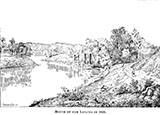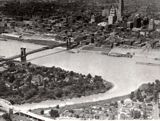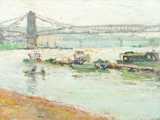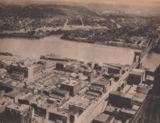
April 14, 1836
A watercolor by David J. Kennedy
That's the Newport Barracks on the left, the Licking River in the
center, and Covington's Carneal House on the right.
1836!!!
Mouth of the Licking, 1850
View up the Licking River, Newport, Kentucky, 1908
“to Mabel Burnwell, Linden Heights, Ohio,
Have been in Covington since Sunday and am not married yet.
It doesn't effect all people the same. Clara.”
![]()
What does the Licking River have to do with the naming
of the City of Cincinnati? We're so glad you asked. Click
here.
![]()
 |
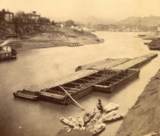 |
 |
|
| 1934 from a Facebook post by Dale Ashcraft, of a photo by his Grandmother Emma Hahn Ashcraft |
Looking North | Boats and wharf boat on the Licking |
Beached Ferries. Why?
Those are Newport Barracks buildings in the background.
 |
 |
 |
| Aerials of the Licking Valley | Licking River | |
January 4, 1918, Mouth of the Licking
 |
 |
|
| February 7,1918 That's the steamer Julius Fleischmann tied up in the Licking |
||
| Devastation was rampant in the ice in the winter of 1917-1918. | ||
Aerial of the mouth of the Licking, c. WWII.
From a Facebook post by Bill Soudrette
A painting by Kate Reno Miller (1874-1929)
 |
 |
 |
| Licking River scenes by artist H. H. Wessel, c. 1930's | ||
 |
 |
|
| 1861. Looking south from the Larz Anderson Civil War Defense Battery, roughly up the hill from Madison at 26th. |
Moonlight on the Licking |
 |
 |
|
| Cows, somewhere in the Licking, c. 1880 | An early Licking River, 1851 lithograph by Otto Onken In July, 1853, the New American Magazine ran a story that went with the above pic. Read it here. | Civil War Soldiers Fording the Licking. Harpers ran two other pictures and an article with the above lithograph. You can read the article, here. The bridge was Placed on August 8, 1864, “just below Cole's Garden.” Cincinnati Enquirer, August 9, 1864. |
![]()
This early (c. 1795) map of Kentucky reflects the earlier name of the
Licking - The Salt Spring River, since it flowed at Kentucky's
Blue Licks [Wikipedia].
Earlier,
Dr. Thomas Walker [Wikipedia] called it Frederick's River.
Still earlier, Native Americans called it the Nepernine.
![]()
 |
| Mouth of the Licking, 1937 Flood |
The 1937 Flood on the Licking, looking northeast toward Newport. This pic is from
January 23, 1937, which is to say, three days before the crest.
![]()
| “The Licking River has its source in Floyd County, Ky., 180 miles from its mouth. It empties into the Ohio, between the cities of Newport and Covington, opposite the foot of Broadway, Cincinnati. It is navigable for steamers as far as the falls at Cole's Gardens, four miles from its mouth. At that point, in dry summers, it has but little water; but in winter and spring flat-boats descend it for 70 or 80 miles. An effort was once made to improve the channel by means of dams and locks, but the enterprise was abandoned.” King's Pocket Book of Cincinnati, 1880 |
![]()
The Island Queen at the mouth of the Licking, c. 1910.
 |
 |
 |
| On the Picturesque Licking River, 1909 |
On the Picturesque Licking River, 1909 |
Licking River at Banklick Creek |

from The Grit, of March 8, 1884.
| Three articles at the Kentucky Tribune's site, on the Licking River: | ||
| Dr. Paul Tenkotte writes on why there are no locks and dams on the Licking, here; | Dr. Paul Tenkotte on the impact of the geology of the Licking, here. | Steve Preston writes on why “The Point” at the mouth of the Licking was important in the Revolutionary War, here. |
| The Licking River ice gorge in 1856. | 1849 Licking River packet schedule. |
| Licking River lock and dam proposal. | An 1879 view of the Licking |
The Hercules Carrell, at the mouth of the Licking, 1912
 |
 |
 |
| Licking River at Banklick Creek | Licking River, at Newport | Licking River, at Newport |
 |
 |
 |
| Licking River Scenes, 1870's | Mouth of Licking An 1899 engraving by J. L. Trout |
|
![]()
March, 1997
| “Leaving Madison County, we all came safe to Campbell County, Kentucky, near the mouth of the Licking River. My grandfather, for many years, had been laboring under an asthmatic affliction, which had so reduced his strength, that he became entirely unable to provide for, or indeed to do anything for himself or family. My mother being their youngest child, and both of them being now quite old, they had quit keeping house, and were living with father and mother, and, of course, moved with them. When we came to Licking River the word came to them, that the Indians had broken out afresh in the Territory, and that the settlers were then in forts and stations. Some of them had been killed, and horses, cattle, etc., had been stolen; hence great alarm pervaded the country.” excerpt from The autobiography of Elder Wilson Thompson, embracing a sketch of his life, travels, & ministerial labors, in which is included a concise history of the old order of regular Baptist churches. Cincinnati, Moore, Wilstach & Baldwin, 1867. |

from the Centinel of the North-Western Territory, November 30, 1793
Jedidiah Morse describes the Licking in 1810.
![]()
